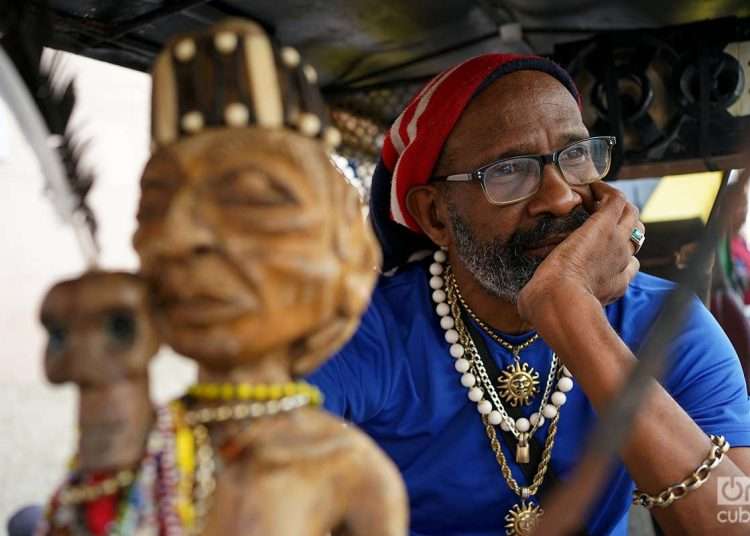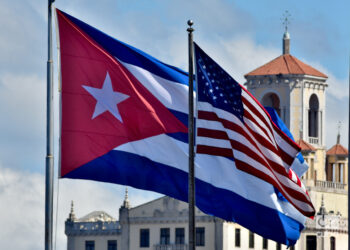To what extent does the freedom that people feel, at a given moment, translate into shared events and experiences, and how is this related to faith? I commented on this question, illustrating it with my successive beliefs, in Roman Catholic Christianity, Protestant Christianity and communism, before and during the process of change that was the Revolution. And I returned to ideas of the doctrine of Jesus; especially, some systematized by the apostle Saint Paul in the New Testament, founded on the acceptance of the other and not on a unilateral and exclusive rule. Finally, I referred to some positions of a part of religious Cubans, ecclesiastical and lay, who do not get along very well with the spirit of reconciliation advocated by the apostle. And I alluded to that Cuba that is reflected in the mirror of United States policies, where it appears on a blacklist of flagrant violators of the principles of religious freedom enshrined in the Constitution.
Freedom to believe? Four notes on faith, politics and people (I)
Note 3
Whether or not the aforementioned churches, denominations and religious people maintain a friendship with the U.S. government doesn’t matter. The fact is that its call for harmony and understanding through conflict and the condemnation of what is not its beliefs, as well as its agreement that there is no religious freedom in Cuba, contribute to promoting that freedom as well as the U.S. policy towards the island.
The criteria for including Cuba on the State Department’s blacklist are based on too simple a principle: all the religious people who appear to be involved in street actions, including the most violent ones; in organizations, the media or political alliances with foreign actors, who operate against the current law in Cuba, are being deprived of their freedom to exercise their faith.
Let’s say that those convicted for the July 11 case, convicted of aggression and violence against the authorities and force in things, in case they have any beliefs, are victims of religious repression. It doesn’t matter that they have not been prohibited from practicing any cult, nor collaborating with the magazines and other media available to churches and denominations, nor practicing or spreading their faith in any other way.
The first question would be how the law in the United States or in any country resolves the question of legitimate actions and rights that are in contradiction with the behaviors advocated by some religious doctrine. As I pointed out before, does the Family Code “encourage systematic tolerance of current and scandalous violations of religious freedom”?
Seen in this way, this law would not be placing Cuba among the handful of thirty-odd countries that enshrine the family rights of minors, the elderly, gays, single mothers and fathers, etc., and that promote advanced education in values and norms of coexistence, but repressing the religious freedom of churches and denominations that oppose these rights as exclusive with their fundamentalist reading of the Scriptures. In other words, deepening “the wound in the soul of Cuba that is the crisis of families,” as some religious people proclaim.
The second question points to the old question of double standards in the judgment of things Cuban. Let’s say, how does the U.S. government judge religious freedom in other countries? Let’s take anyone, for example, France. The Department of State’s 2022 Report says this:
“The [French] government dissolved by decree several Muslim organizations which it accused of ‘inciting hatred, violence and discrimination’ and said it had closed 672 Muslim establishments from February 2018 to October 2021, including 21 mosques since November 2020…the number of anti-Muslim acts increased by 38%…anti-Christian acts decreased to 857, and anti-Semitic acts fell 14% to 589.”
Instead of condemning the high degree of religious conflict in France, and the actions of the government, the United States would be contributing to interfaith understanding through “projects that brought together young people of different faiths and a round table with religious leaders and making use of social media to broadcast messages that highlighted issues related to religious freedom.” Instead of preferring some churches and religious people over others and adding fuel to the fire to their differences with the government, in the case of France, the United States would be promoting dialogue, including interreligious dialogue.
That official U.S. vision is not usually confused when judging conflicts of an apparently religious nature in other countries; Let’s say Mexico. The State Department’s 2022 Report states:
“Government officials, non-governmental organizations (NGOs) and evangelical and Roman Catholic representatives agreed that the roots of these conflicts often lie in a combination of political, ethnic or land disputes, which are often related to the traditional ‘uses and customs’ of indigenous communities.”
It doesn’t take much subtlety to note that if Cuba is treated as a “critical case” on religious freedom, it has something to do with its placement in the landscape of U.S. political preferences and tastes.
A third question raised by the unrestricted use of the concept “repression of freedom of belief” in Cuba is rather simple: And what does the U.S. government know about religions and religiosity in Cuba to put it that way?
According to its sources, the State Department’s 2022 Report affirms that 60% of Cubans are Catholics, only 5% are Protestants, the majority Pentecostals and Baptists. The remaining 35% includes Jews, Muslims, Buddhists, followers of the Baha’i faith, etc.
It is striking that in this detailed inventory, based on sources as independent as the churches themselves, the place occupied in Cuban religiosity by Santeria, the rule of Ocha, Palo Monte, Abakuás, is limited to the following: “many people, Afro-Cubans in particular, practice religions with roots throughout the world.… These religious practices are interspersed with Catholicism and other forms of Christianity, and some require Catholic baptism for full initiation, making it difficult to accurately estimate their total membership.”
With these phrases, they dispatch the main component of Cuban religiosity, as has been described by anthropologists of all political persuasions, before and after 1959.
“Beliefs of blacks who are actually Christians, because they are baptized.”
Note 4
Treading this shifting ground and subject to such diverse — often biased — sources requires resorting to the sociology of religion. So I talked to two researchers, Pedro Álvarez Sifontes and Yuniel de la Rúa, both authors on the team that just concluded a far-reaching study on religious freedom in Cuba, produced by the Center for Psychological and Sociological Research (CIPS).
For those who appreciate the profound changes that have characterized Cuban society since the 1990s, those that are expressed in the religious panorama are not surprising. The first thing that the investigations affirm is the insufficient data that is handled — many of them distorted by the vision of the churches themselves with greater resources. Some international Catholic institutions — also cited by the U.S. government — affirm that 61.7% of the Cuban population is Christian, 17.2% is agnostic, 3.9% is atheist, 16.7% is a spiritualist, and 0.5% profess other religions.
Yuniel de la Rúa comments that this picture is impossible: “It cannot be that more than half of the Cuban population is Christian, although we know that it has grown a lot, especially the evangelicals; and, above all, we do not see the Cuban religions of African origin represented, which is also evident that they have increased a lot.”
For both researchers, the strongest proof of freedom of religion in Cuba is the proliferation of churches, denominations, and religious expressions of all kinds.
According to Pedro Álvarez Sifontes, the 2022 figure included “fifty-six religious denominations registered in the Registry of Associations of the Ministry of Justice.” This is only a fragment of the Cuban religious landscape, since “there are between thirty and forty denominations or expressions of evangelical origin throughout the country that are not registered.” The Catholic Church, the Jehovah’s Witnesses, or many other Protestant Christian churches are not, by the way, in that list of associations.
“If we included all the Protestants in one, including the most recent evangelicals, we would find between forty and fifty different religious expressions,” he adds. But “if we were to count them in their differentiated selves, as they identify themselves, there would be well over a hundred.”
In that sea of separate denominations are Methodists, Presbyterians, Episcopalians, Seventh-day Adventists, Lutherans, Gideon’s Evangelical Band, Quakers, The Salvation Army, Western, Eastern, Free Baptist federations, the First Church of God, the Church of Christ Scientist, up to twenty-seven different Pentecostal churches. In addition to the associations and temples dedicated to Santeria, which exponentially multiply Christians throughout the country. As well as those of the Baha’i Faith, Hare Krishna, Muslims, Buddhists, Greek Orthodox Catholics and Russian Orthodox, Jews…
The difficulty in drawing up an accurate map — not only of churches and denominations but of religious manifestations in the country — is related to the way in which religiosity is experienced in Cuban culture. Pedro and Yuniel assure me that it is common to find, on their tours of the country, people who believe in “several things at the same time.” That multireligiousness, they say, is typical of popular religiosity in Cuba.
“Freelance Christians” who don’t go to any church; “individuals who practice seven things at the same time, including Santeria and reading the Bible,” and other cases that give a particular color to religious beliefs and the question of freedom.
I take advantage of the fact that I have them in front of me to pepper them with questions. At what point are we in the relations between the religious field and politics? Are the existing regulations for conducting services clearly defined? Do the churches have the means of diffusion to get their message across to the population? What educational, cultural, social activities can they carry out? Which institutions and manifestations pose a greater conflict of interest with the established policy? Do prejudices or cultural differences regarding churches and religions persist among institutions and decision-makers at the grassroots level? To what extent do various religious denominations and churches share common positions on religious freedom today?
I could continue adding questions, but I prefer to leave it there. See you in a coda to these four notes.
To be continued…
First issue of the series: Freedom to believe? Four Notes on Faith, Politics and People (I)










